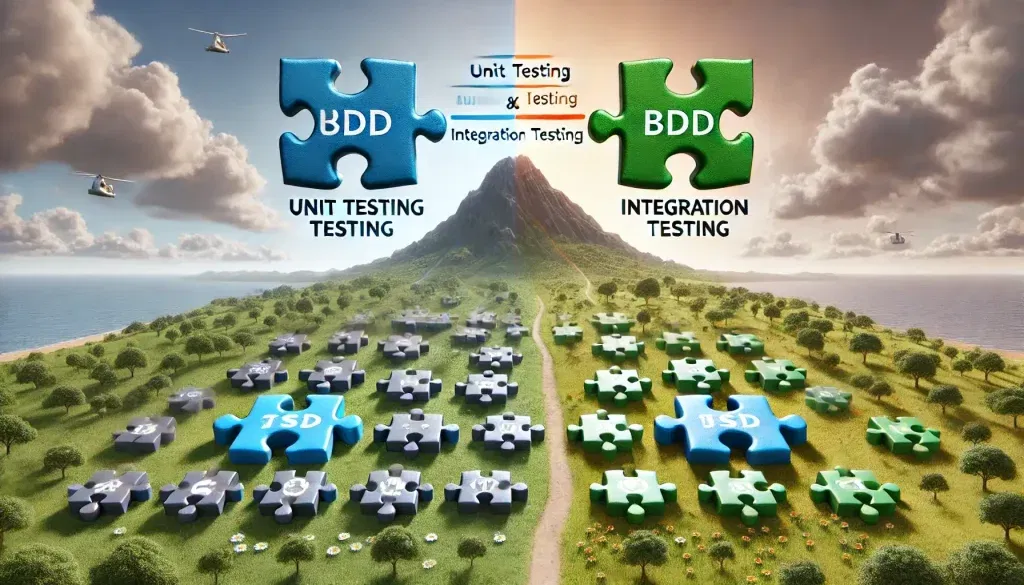When it comes to software development, application testing is a must to ensure the running of the application in the real world. To make sure that the app testing is done right, there are various methodologies and frameworks designed to enhance the efficiency and accuracy of testing processes. Out of all these topics, the BDD framework for testing and the comparison between unit testing and integration testing are particularly notable for their popularity and efficiency. This piece explores these subjects, explaining their importance. How they relate to the larger landscape of software development.

Contents
What is BDD Framework in Testing?
The BDD framework in testing, also known as Behavior-Driven Development, is a combined software development approach that includes test-driven development and domain-driven design. The BDD framework approach ensures that everyone understands the project requirement by involving the developers, QA’s, and non-technical stakeholders. This framework utilizes natural language constructs so that the test cases created are easy to understand by everyone involved in the project development.
The main concept when defining what is BDD framework in testing is its ability to explain how the software behaves based on its business significance. This is commonly achieved through the use of the Gherkin language, which organizes test cases into a Given structure;
- Given sets up the initial context or status of the system.
- When describes the action or event that triggers the behavior.
- Then state the expected result.
The BDD testing framework ensures that software aligns with user requirements by emphasizing behavior and outcomes over implementation details.
Unit Testing vs Integration Testing
Knowing the variance between unit testing and integration testing holds importance in software development. Each type of testing has its role to play, serving distinct purposes within the process.
Unit Testing: Testing components or units of the software in isolation is known as unit testing. The main objective is to confirm that each unit operates correctly. Developers usually create these tests. They serve as a defense against bugs. Unit tests are quick to write and simple to execute. Are run regularly to detect problems in the development process. They guarantee that all aspects of the code perform as planned, playing a role, in upholding code quality and supporting refactoring efforts.
Integration Testing: Integration testing, however it is about checking how components or systems interact with each other. In contrast to unit tests that focus on application parts, integration tests assess the effectiveness of these parts when they come together. This form of testing is crucial for identifying problems with interfaces, data formats, and other errors that can occur during interactions. Issues that unit tests may overlook. By conducting integration tests, we can ensure that all components of the application work as intended, thus instilling greater confidence in the system’s overall reliability.
Comparison: Unit Testing vs Integration Testing
When comparing unit testing vs integration testing, several key differences emerge:
- Scope: Unit testing concentrates on assessing components, whereas integration testing scrutinizes the connections among integrated components.
- Objective: Unit testing is about verifying the functioning of each module of the application individually. While in integration testing all the unit modules are combined in a group to ensure the compatibility and proper working of each module.
- Complexity: Unit tests can be automated easily and are relatively simple and fast to execute when compared with integration testing. As testing process of little more complex as there are multiple modules are being tested.
- Mocking: To execute a unit test, mock objects replicate the dependencies. In contrast, integration testing uses real dependencies.
Conclusion
It’s important to grasp the concept of the BDD framework in testing and distinguish between unit testing and integration testing for software development and testing. BDD promotes teamwork and transparency, resulting in software that aligns better with business needs. Unit testing verifies the functionality of parts, whereas integration testing confirms how these parts interact with each other.
By implementing these strategies and structures, teams working on development can produce software with issues and more reliable results. At ACCELQ, we make use of the advantages offered by BDD frameworks, unit testing, and integration testing to create top-notch software solutions. Our method guarantees that your software not only fulfills its needs but also offers a smooth and dependable user experience.
By merging the teamwork aspect of BDD with the meticulousness of unit and integration testing, ACCELQ supports you in creating software that can handle real-world obstacles and provide benefits to your users.



